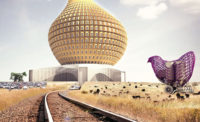The 2015 Chicago Architecture Biennial purports to be the largest survey of contemporary architecture to hit North America to date, and leading the monumental effort as its artistic directors are Sarah Herda and Joseph Grima. Herda has served as the director of the Graham Foundation for Advanced Studies in the Fine Arts, a project-based grant-making organization, since 2006. Grima, based in Genoa, Italy, was the editor of the design magazine Domus from 2011 to 2013. Prior to Domus, Grima directed New York’s Storefront for Art and Architecture from 2007 to 2011, succeeding Herda’s tenure in the same role from 1998 to 2006. Drawing on their shared experience at Storefront and their overlapping networks, Herda and Grima together curated the Chicago Biennial, titled The State of the Art of Architecture, with an eye to innovation, idea-generation, and global dialogue.
Architectural Record: What themes were most salient as you began thinking about the biennial?
Sarah Herda: When Joseph and I began working on the biennial, we were very conscious that this is the first one—it’s laying the groundwork for future biennials—so instead of focusing on one specific theme or issue or asset, we wanted to capture the diversity of practices and different ways in which architects are practicing today. We did that by casting a wide net around the world.
Joseph Grima: Our idea was to take this opportunity to step back and create an exhibition that was a roundtable of sorts that invites a number of divergent positions from many different backgrounds. By bringing them together and putting them in dialogue with one another, we can look as much for the points of divergence and tension as for the points of convergence or consensus.
How important was it to spotlight Chicago-based firms and practitioners within such a diverse show?
JG: It was very important to us that the city of Chicago be strongly represented in the exhibition because the city occupies a very specific position within the history of architecture. Chicago has been so influential on so many other cities. In many ways, Chicago would have been lingering in the background wherever this exhibition had been.
SH: It makes so much sense to have this global convening in Chicago, because the city’s been a laboratory for ideas for well over 100 years. That sense of experimentation is a perfect backdrop to talk about what’s possible now and what we want and need from architecture in the future.
The biennial’s title—The State of the Art of Architecture—refers to architecture as an art, not a craft, not something utilitarian. How does the exhibition reflect this?
JG: We really like that this title refers to the idea of “state of the art”—the most advanced, the exemplification of modern architecture. But it also indicates that architecture is not simply a utilitarian practice that provides shelter but is also an art—a form of cultural expression. This is an extraordinary opportunity to demonstrate how architecture responds to so many different questions on the spectrum of human need, which is something that’s not always completely clear in the mind of the public.
SH: Everybody interacts with architecture every day, but often the public interacts with architectural ideas only once they’re actualized. We’re highlighting ideas that shape buildings, and we want to put people in contact with these ideas. We really worked with participants to explore the ways in which they represent their ideas, so a lot of the show is devoted to hand-drawing and experimenting with other mediums to express architectural ideas.
JG: Ultimately we were more interested in the ideas embedded in the projects—whether they were built or unbuilt, realized or unrealized, or simply represented through paintings or drawings.
What outcomes do you hope to see?
JG: It’s really important that, in the longer term, this exhibition generates debate. Inevitably, amazing collaborations will be born out of this. Opportunities for people to converge and experiment are incredibly important for fostering innovation and improving the general quality of architecture. I hope it’s something that will be imitated by other cities, and I’m really excited to see in 10 or 20 years what the effects will be.
Listen to the audio extra below for more from Joseph Grima and Sarah Herda, with music by Yusuke Tsutsumi.



Post a comment to this article
Report Abusive Comment